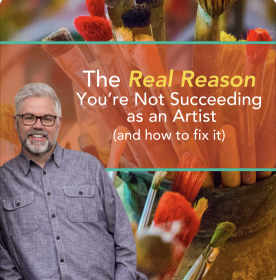Have you ever wondered how to sell art online? You have a website, you’re on social media, and you’ve got the new collection ready to sell, but where do you start? Whether you’re new to the game or are already a seasoned pro, here are 5 keys that will unleash your online art sales this year and give you more understanding of how to be a successful artist.
Key #1 – Artist, Know Thy Customer
First things first. Start by discovering your ideal client. Who is the person most likely, out of everybody in the world, to buy your work and put it in their home or commercial space? As artists, we’d like to think that the whole world is a potential client, but that’s just not the case.
In my Created to Thrive Artist Mentoring Program, I teach artists how to create a client avatar, or what some call a buyer persona. This is a semi-fictional representation of your ideal client based on what you know about your existing customers and the research you do in your local and regional art marketplace.
Listen To What I Said On My Podcast About This:
Have you ever wondered how to start generating sales for your artwork? Well, as a creative, that’s THE question, right?
I get asked this all the time, and in my blog and this episode of 5-Minute Mentoring, I’ll be answering this question and laying out a clear pathway so you can start generating some real sales for your art today.
Connect with Matt online at www.MattTommeyMentoring.com or on Instagram and Facebook @thethrivingchristianartist
Get encouraged and connect with other artists on the Thriving Christian Artist Facebook Page https://www.facebook.com/thethrivingchristianartist/
Fuel Your Creative Calling with Weekly Encouragement
Join thousands of Christian artists who are growing in faith, creativity, and purpose.
Subscribe to The Thriving Christian Artist Weekly and receive powerful, faith-filled content every week—designed to encourage your heart, spark your creativity, and equip you to walk boldly in your God-given calling as an artist.
? Click here. It’s free. It’s faith-filled. And it’s just for you.
Have you ever wondered how to start generating sales for your artwork? Well, as a creative, that’s THE question, right?
I get asked this all the time, and in my blog and this episode of 5-Minute Mentoring, I’ll be answering this question and laying out a clear pathway so you can start generating some real sales for your art today.
Connect with Matt online at www.MattTommeyMentoring.com or on Instagram and Facebook @thethrivingchristianartist
Get encouraged and connect with other artists on the Thriving Christian Artist Facebook Page https://www.facebook.com/thethrivingchristianartist/
Fuel Your Creative Calling with Weekly Encouragement
Join thousands of Christian artists who are growing in faith, creativity, and purpose.
Subscribe to The Thriving Christian Artist Weekly and receive powerful, faith-filled content every week—designed to encourage your heart, spark your creativity, and equip you to walk boldly in your God-given calling as an artist.
? Click here. It’s free. It’s faith-filled. And it’s just for you.
Creating a client avatar (buyer persona) is easier than it sounds, and you’re probably already doing it to some degree and don’t realize it. It’s just the process of paying attention to the interactions and conversations you’re having with customers every time you sell a piece of art and collecting that data. Even if you’ve only ever sold one piece of art, you know something about the person who bought your art.
This is a process that really never ends because every piece you sell is another chance to interact with people from a client perspective, from a strategic partner perspective, from a gallery perspective, and a referral perspective. As you do this over time, you’ll start to get a great picture of who these people are, what motivates them, what they’re looking for, and where and with whom they hang out, which brings me to the second key.
Key #2 – Go Where the Clients Are
In a recent article about how to sell art if you live in a rural area, I said, “If you want to catch fish, you have to go to where the fish are.” Makes sense, right? The same holds true with finding customers. Once you understand who your ideal client is and what they are into, it’s time to develop what I call intersection points. The goal here is simple, regularly getting in front of your ideal client using a variety of strategies.
Now that you are starting to understand who your ideal customer is, you want to be found by them. In the real world, you can do this through a variety of ways like exhibiting at the kind of art shows they frequent, volunteering for the non-profits they support, and speaking at social clubs they’ve joined.
But don’t let social distancing or physical separation keep you from being found. Advertise in the types of magazines they read, start collaborating with the interior designers they are using, and follow common social media interests. Again your goal is to cross paths with your ideal clients in as many natural non-salesy ways as you can so that they can find you. And this leads us to the next key.
Key#3 – Connect (Like Your Art Sales Depend Upon It)
The point of the first two keys is to get you talking with your ideal client. If you don’t remember anything else I share, remember this:
No Connection, No Sale.
People buy from people that they know, like, and trust. Think about that for a second. As an artist, you have to build a connection with your client so that they feel connected to you, your aesthetic, and the work you’re producing. If you don’t build those connections, you won’t have many opportunities to make a sale.
So, again, these connections are built up over time, and they’re developed along with those naturally occurring intersections points you’re beginning to seek out intentionally. As the relationship grows with your ideal client, so will their interest in owning one of your pieces, which brings me to the next key.
Key #4 – Make the Offer Clear
The confused mind rarely buys. Now that you’ve got a potential client interested make it easy for them to shop. In simple terms, let your clients know precisely what they get from you when they invest in one of your creations. You should include details like:
- The name of the piece
- A good description
- The dimensions of the piece
- The mediums and media used
- If delivery is available and included
- If framing is available and included
- Available payment options
- The price
Whatever it is that you’re offering, make sure those details are available to a client browsing your website. This holds true whether you’re selling finished pieces, prints, or commissioned originals.
Create a clear, compelling offer
This brings me to the final key.
Key#5 – Keep Your Checkout Process Simple
Make it easy for people to give you money. I recently had an experience with a local merchant that drove this point home for me. Instead of a quick swipe, signature, and press of the yes key, I received a 10-minute lesson in loving my technologically challenged neighbor.
It’s so easy to accept credit cards, checks, wire transfers, and even cryptocurrencies online, over the phone, and in-person in today’s world. There’s really no excuse for making it hard for a customer to do business with you.
Don’t know where to start? Check out Square. They are great. I use them for accepting credit and debit cards both online and in person.
So, there you have it, my top 5 tips selling your art, online and otherwise. Remember the keys:
- Create Your Client Avatar
- Develop Those Intersection Points
- Cultivate Authentic Connections
- Create Clear Compelling Offers
- Keep the Checkout Process Simple
Got Questions? I’d Love to Answer Them
I sure hope this has been helpful. If you have a question for me, I’d love to answer it here in my blog and on a future episode of 5-Minute Mentoring. Just stop by my podcast page and leave me a voicemail. Thanks for reading.



Leave a Reply